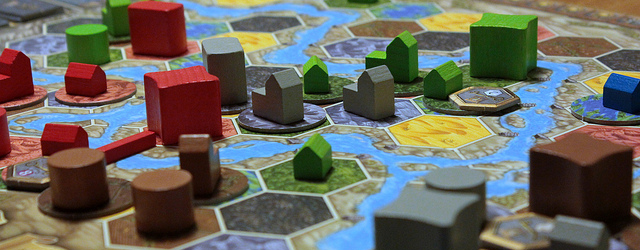| Strategy | Luck |
|---|---|
| Interaction | Components & Design |
| Complexity | Score |
Or maybe not so creative, you just have to invest the labour: terraforming in Terra Mystica is done with a spade. Converting a field on the board into your home terrain is done by hand, by workers, and more expensive the less similar the terrain is to what your people need. That’s not always logical – why is it easier to create a forest from a rocky mountain than from fertile plains? – but it’s at least consistent: each step of transformation is paid for with three Workers. Workers, by the way, are just one of the four resources you have to try and balance in Terra Mystica, it’s not a worker placement game. When terraforming is done, you can use more workers and some money to build a Dwelling on the reshaped land. Building a Dwelling irrevocably marks the place as yours. Other players can undo your terraforming until you build a Dwelling, but once you do, the place is yours alone. There is no way to destroy a Dwelling, loot it, plunder, pillage, burn or otherwise eradicate it. Terra Mystica is completely violence-free, but that doesn’t mean it’s peaceful.
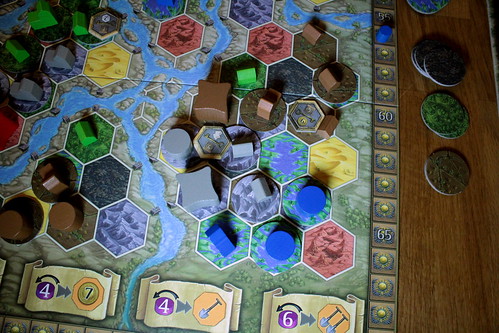
Sprinkling your Dwellings over the landscape is only the start, each Dwelling is the starting point for a line of upgrades, from Dwelling to Trading House and from there either into a Stronghold or into a Temple and then a Sanctuary. Upgrading in itself doesn’t do anything for your success, buildings are not worth any victory points. Removing a building from your player board does, however, reveal income under it that you will receive every round after you revealed it. On the downside, the building you just upgraded goes back on your player board and covers its related income again. For instance, upgrading a Dwelling into a Trading House gives you, with some minor variations, an income of two Coins and one Power (that’s capital-P-Power, we’re getting to that), but putting the Dwelling back means one worker less per round. Building a Temple is worth a rare and valuable Preeple – Priests are the only meeples in this game, which is sort of sad – but the Coins and Power are gone again. But the most awesome upgrade is the Stronghold which has a different income for each of the 14 races and also enables a unique, powerful special ability that, together with their other ability that is available from the start and their different starting resources makes every race a very different experience to play. New Dwellings can, by the way, only be placed next to your existing buildings. Place enough and big enough buildings adjacent to each other and they spontaneously create a City and give you a little point boost and another bonus of your choice, selected from the available City Tiles.
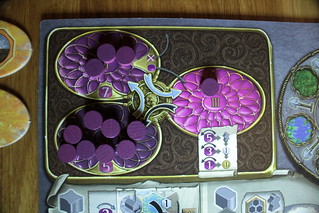
With all that building and founding cities, your top objective would seem to be having enough space. And that’s true. But it’s only half of the truth, because on the other side of things there is Power, which is gained from other people building adjacent to your buildings. Power represents political and economic influence, and you don’t gain that by isolating yourself from the rest of the world. Power is one of those things that sound complicated and baroque when explaining the rules but work smoothly and naturally when playing Terra Mystica. Each player has a total of twelve power disks, no more, no less. Those are spread around three bowls, lets call them the Bowls of Power because it sounds silly but still better than Bowels of Power. When you gain Power, you move disks from bowl one to bowl two and finally to bowl three. Only Power in bowl three can be used for Power Actions – sounds pretty bad ass, doesn’t it? – like buying additional resources, doing some worker-free terraforming or building one of your three bridges that lets you create a city across rivers. The three bowl setup looks weird at first, but what it does is create a steady flow of power that, at the same time, is not always available. Managing your power well is a challenge, but you won’t win without it.
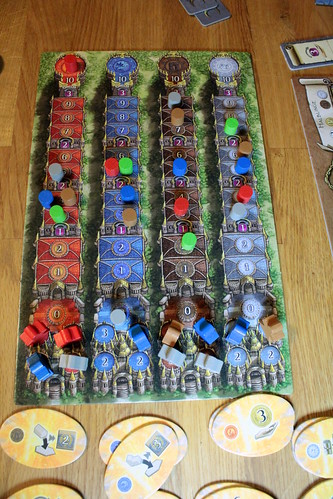
That only leaves Priests as the last resource we didn’t look at. Like I said before, they are the hardest to come by, but they are amazingly useful as well. Those guys are very useful for science, because this is the old days when priests were also scholars: you use priests to invent better terraforming, using fewer workers to transform a piece of land, and to upgrade your shipping, enabling you to build new Dwellings far off from your old ones along the rivers. But priests also have a religious use, you may send them to one of the four elemental cults to increase your standing there. Yeah, that’s right, there’s yet another element to consider. Advancing in one of the four cults sometimes gets you some power, but more importantly it wins you a nice amount of points to be a cult leader at the end of the game. Finally, some mention of points. Last, and also not least, your standing in the cults is worth a nice bonus at the end of each of the six rounds: the Round Marker shows a cult requirement and a reward for having the required standing there. Like an additional worker for each two points in Air that you have. Very nice. And also randomized at the start of the game, so in some games one cult may be vastly more useful than in another.
The Round Marker also has a scoring rule for each round, like scoring two points for every Dwelling you build, or five for building your Stronghold or Sanctuary. This is another important source of points, so you want to try and take your actions in a round where you score for taking them. Of course, that is usually the opposite of what would be most useful for you strategically and you’ll have to make tough decisions when weighing between scoring points and strengthening your position. But tough decisions is what Terra Mystica is all about, nothing is ever easy. Even passing for the round is an agonizing decision, because when you pass you select a Bonus Tile for the next round that has additional income or, more rarely, special actions. But there are only three to pick from, when you pass and take a new one you return your old one. Sometimes you’ll want to pass early to get your preferred bonus before anyone else. At other times, you desperately try to take more actions when you’ve already run out of resources because you really want someone else to return their bonus tile first so you can pick it up again.
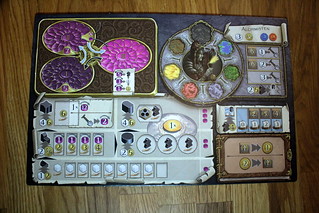
And all this is still only the rough overview, there are details to be mentioned on everything, but if I were to get into those most eyes would glaze over. That’s what happened with most new players, too. After half the explanation, blank stares and calls of “Lets just start and see”. And then the miraculous thing happened every single time: playing Terra Mystica worked. Even with all the options and details to keep in mind, no one was left behind without a clue what to do. Once you start playing, everything in Terra Mystica is logical and obvious. It helps that there are almost no exceptions to any rule, when the rulebook says something is like this, then it is always like this, the only exception being racial abilities. Another reason why everyone we played with had an easy time getting into the game are the amazingly well-designed player boards. Really, I’m in love with those things. They show you all the information you need at a single glance: income, costs, your Power, the circle of terraforming and your special abilities, they remind you to take a Favour Tile whenever you build a Temple or Sanctuary, they even remind you of that little rule where you can permanently remove a Power chip from your Power cycle in order to move another one to the mighty third bowl. It’s all there, and I’m willing to call those boards one of the best thought out component in a boardgame ever.
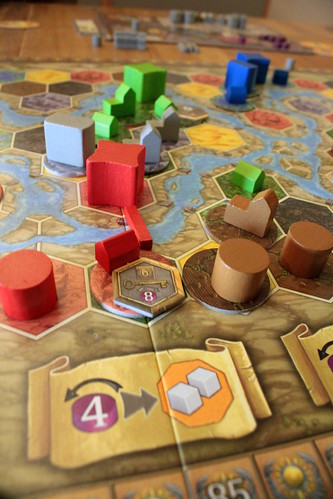
But Terra Mystica has way, way more parts that are well thought out, namely almost everything. Literally everything you do is meaningful, every turn you make a decision that is important and will have consequences down the line. What you build, when you build it, where you build it. What cults to invest in and when. Which of the expensive upgrades to your terraforming and shipping to buy. When to pass. What tile to take. Whether to get close to your opponents for the promise of power or make sure you have your space. And next time you play, everything you strategized will be different, because the Round Markers will be different, the Bonus Tiles will be different, and you will play a different one of the 14 races, with different abilities, forcing you into another strategy. The replay value of Terra Mystica is astonishing. The only thing that doesn’t change is the game board.
And despite all that, even with four or five players, Terra Mystica never drags. It’s a long game, but it keeps everyone in the action, long breaks for someone to come up with a new strategy are rare. I’m not usually one to jump on the bandwagon when everyone is raving how great a new game is, but in this case every single good thing that has been said is justified. I’ve rarely seen a game this tense and yet accessible, it deserves all the buzz it got after last year’s Essen fair.

